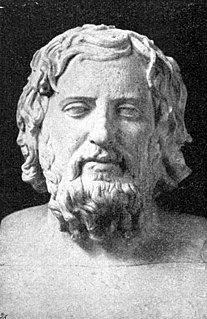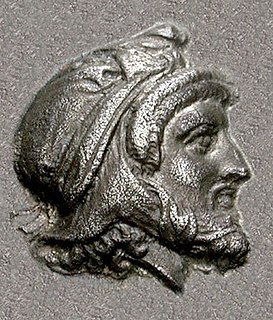
Xenophon of Athens was an Athenian-born military leader, philosopher, and historian. Xenophon was elected a commander of the Ten Thousand Greek mercenaries at the age of 30. As the military historian Theodore Ayrault Dodge wrote, "the centuries since have devised nothing to surpass the genius of this warrior". Xenophon established precedents for many logistical operations, and was among the first to use flanking maneuvers and feints. Xenophon's Anabasis recounts adventures of Xenophon and the Ten Thousand in service of Cyrus the Younger, Cyrus's failed campaign to claim the Persian throne from Artaxerxes II of Persia, and the return of Greek mercenaries after Cyrus's death in the Battle of Cunaxa. A student and a friend of Socrates, Xenophon wrote several Socratic dialogues - Symposium, Oeconomicus, Hiero, a tribute to Socrates - Memorabilia, and a recount of the philosopher's trial in 399 BC - Apology of Socrates to the Jury. Xenophon is best known for his historical works. The Hellenica continues directly from the final sentence of Thucydides' History of the Peloponnesian War covering the last seven years of the Peloponnesian War and the subsequent forty two years ending with the Second Battle of Mantinea.

The 5th century BC started the first day of 500 BC and ended the last day of 401 BC.
This article concerns the period 409 BC – 400 BC.

Lysander was a Spartan admiral who commanded the Spartan fleet in the Hellespont which defeated the Athenians at Aegospotami in 405 BC. The following year, he was able to force the Athenians to capitulate, bringing the Peloponnesian War to an end. He then played a key role in Sparta's domination of Greece for the next decade until his death at the Battle of Haliartus.
Year 401 BC was a year of the pre-Julian Roman calendar. At the time, it was known as the Year of the Tribunate of Potitus, Cossus, Camillus, Ambustus, Mamercinus and Iullus. The denomination 401 BC for this year has been used since the early medieval period, when the Anno Domini calendar era became the prevalent method in Europe for naming years.
Ctesias, also known as Ctesias the Cnidian or Ctesias of Cnidus, was a Greek physician and historian from the town of Cnidus in Caria, when Caria was part of the Achaemenid Empire.

Cyrus the Younger, son of Darius II of Persia and Parysatis, was a Persian prince and general, Satrap of Lydia and Ionia from 408 to 401 BC. His birth date is unknown, but he died in 401 BC during a failed battle to oust his elder brother, Artaxerxes II, from the Persian throne.

Clearchus or Clearch, the son of Rhamphias, was a Spartan general and mercenary, noted for his service under Cyrus the Younger.

Tissaphernes was a Persian soldier and statesman, Satrap of Lydia. His life is mostly known from the magistral works of Thucydides and Xenophon. According to Ctesias, he was the son of Hidarnes III and therefore the great grandson of Hydarnes, one of the six conspirators who had supported the rise of Darius the Great.

Artaxerxes II Mnemon was the King of Kings of the Achaemenid Empire from 404 BC until his death in 358 BC. He was a son of Darius II and Parysatis.

The Battle of Cunaxa was fought in 401 BC between Cyrus the Younger and his elder brother Arsaces, who had inherited the Persian throne as Artaxerxes II in 404 BC. The great battle of the revolt of Cyrus took place 70 km north of Babylon, at Cunaxa, on the left bank of the Euphrates. The main source is Xenophon, a Greek soldier who participated in the fighting.

Pharnabazus II was a Persian soldier and statesman, and Satrap of Hellespontine Phrygia. He was the son of Pharnaces II of Phrygia and grandson of Pharnabazus I, and great-grandson of Artabazus I. He and his male ancestors, forming the Pharnacid dynasty, had governed the satrapy of Hellespontine Phrygia from its headquarters at Dascylium since 478 BC. He married Apama, daughter of Artaxerxes II of Persia, and their son Artabazus was likewise a satrap of Phrygia. His grand-daughter Barsine married Alexander the Great.

Anabasis is the most famous book of the Ancient Greek professional soldier and writer Xenophon. The seven books making up the Anabasis were composed circa 370 BC. Anabasis is rendered in translation as The March of the Ten Thousand and as The March Up Country. The narration of the journey is Xenophon's best known work, and "one of the great adventures in human history".

The Ten Thousand were a force of mercenary units, mainly Greeks, employed by Cyrus the Younger to attempt to wrest the throne of the Persian Empire from his brother, Artaxerxes II. Their march to the Battle of Cunaxa and back to Greece was recorded by Xenophon, one of their leaders, in his work Anabasis.
Parysatis was a powerful Persian Queen, consort of Darius II and had a lot of influence during the reign of Artaxerxes II.
Eteonicus was a Spartan commander during the Peloponesian and Corinthian Wars. He participated in many key engagements, held important commands and is mentioned multiple times by Thucydides, Xenophon and Diodorus Siculus. His appearance in the record, however, is mostly episodic, with his roles not being particularly influential.
Meno, son of Alexidemus, was an ancient Thessalian political figure. Probably from Pharsalus, he is famous both for the eponymous dialogue written by Plato and his role as one of the generals leading different contingents of Greek mercenaries in Xenophon's Anabasis.
Ariaeus was a Persian general who fought alongside Cyrus the Younger at the Battle of Cunaxa and later was involved in the assassination of Tissaphernes.
Socrates was a Greek mercenary general from Achaea who traveled to Persia to fight at the Battle of Cunaxa. Xenophon describes him as brave in war and a reliable friend. Socrates was summoned by Cyrus, with whom he was already connected, to bring as many troops as he could muster under the pretense that Cyrus intended to attack Tissaphernes. Socrates had previously been besieging Miletus alongside Pasion the Megarian. Socrates brought Cyrus about 500 Hoplites. Socrates and the other troops were only later told that Cyrus intended to seize the Persian throne from his brother Artaxerxes. Socrates fought at the Battle of Cunaxa and the Greek forces were able to drive the Persians into retreat, but Cyrus and his force faced heavy casualties and Cyrus himself was killed in battle.

Cheirisophus was a Spartan general who fought with the Ten Thousand under Cyrus the Younger. Cheirisophus was sent by the Spartan ephors with 700 heavily armed men to aid Cyrus the Younger in his expedition against his brother Artaxerxes in 401 BC. He joined Cyrus on his march at Issus in Cilicia. After the Battle of Cunaxa, Clearchus sent Cheirisophus with a delegation to the Persian general Ariaeus to make an offer of placing him on the Persian throne, an offer which Ariaeus declined.











